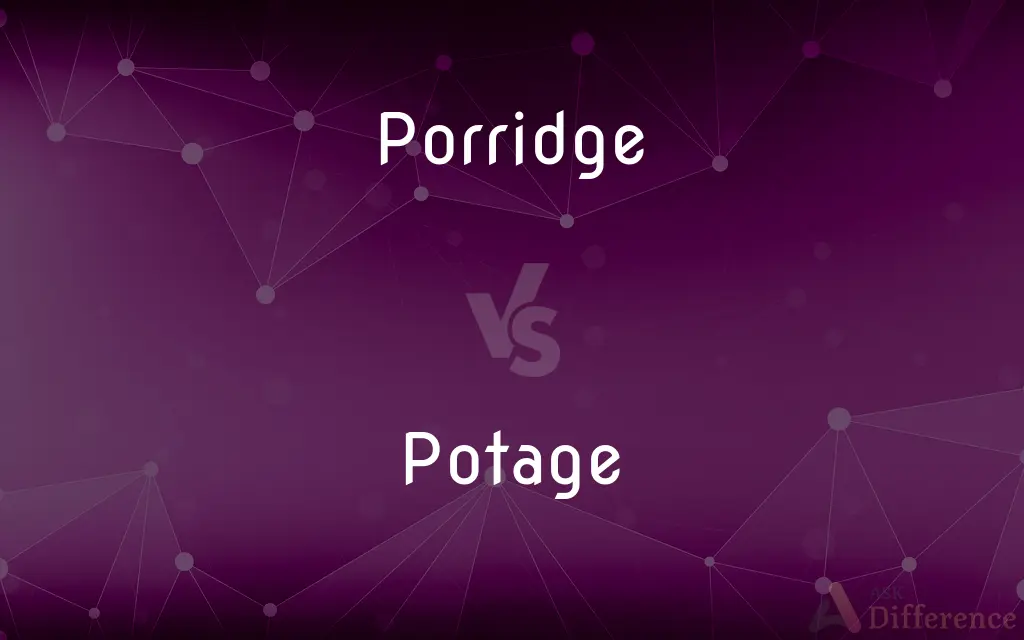Porridge vs. Potage — What's the Difference?
By Maham Liaqat & Fiza Rafique — Updated on May 3, 2024
Porridge is a simple, thick dish typically made from oats and water or milk, often eaten for breakfast, whereas potage is a thick, creamy soup made from meat, vegetables, and stock, served as part of a meal.

Difference Between Porridge and Potage
Table of Contents
ADVERTISEMENT
Key Differences
Porridge is traditionally made by boiling ground, crushed, or chopped starchy plants—typically grain—in water or milk, often seasoned with spices, nuts, or sweeteners. On the other hand, potage is a type of thick soup which originated in medieval Europe, prepared with more ingredients such as meat, vegetables, and legumes, and is often enriched with cream or egg yolks.
While porridge is generally considered a breakfast dish in many cultures, offering a simple, hearty start to the day, potage serves as a more substantial meal component that can be consumed at lunch or dinner.
The consistency of porridge can vary from light and fluffy to thick and creamy, depending on the type of grain used and the cooking method. Whereas potage is intentionally cooked to a thicker consistency, sometimes even pureed to achieve a smooth, creamy texture.
Porridge is typically sweetened with sugar, honey, or fruit, catering to a sweeter palate. Conversely, potage is seasoned with herbs and spices, reflecting a savory flavor profile that complements its complex ingredients.
Nutritional content in porridge primarily focuses on carbohydrates with some fiber, especially if whole grains are used. On the other hand, potage is more nutritionally diverse, containing proteins from meats or legumes, vitamins from vegetables, and often, added fats from cream.
ADVERTISEMENT
Comparison Chart
Base Ingredient
Grains (oats, rice, cornmeal)
Meat, vegetables, legumes
Typical Meal Time
Breakfast
Lunch or dinner
Consistency
Can vary from light to thick
Usually thick, often pureed
Flavor Profile
Typically sweet
Savory
Nutritional Focus
Carbohydrates, fiber
Proteins, vitamins, fats
Compare with Definitions
Porridge
A dish consisting of oatmeal or another cereal boiled to a thick consistency.
Porridge is often topped with honey and nuts for added flavor.
Potage
A thick, creamy soup usually made with meat, vegetables, and stock.
The chef served a rich potage as the first course of the meal.
Porridge
A simple, staple food often associated with health and wellness.
Porridge is recommended in many diets for its high fiber content.
Potage
A traditional European dish that can be traced back to medieval times.
Potage was a staple in medieval European diets, often eaten daily.
Porridge
A breakfast dish that is highly customizable with fruits, spices, or sweeteners.
She prefers her porridge with sliced bananas and a sprinkle of cinnamon.
Potage
A savory soup that can include a variety of seasonings and cream.
The potage was flavored with fresh herbs and a touch of cream.
Porridge
Traditionally a peasant dish, now considered a comfort food in many cultures.
Porridge has evolved from a basic necessity to a trendy breakfast option.
Potage
A versatile dish that can be made from whatever ingredients are available.
She made a delicious potage using leftover vegetables from the refrigerator.
Porridge
Porridge is a food commonly eaten as a breakfast cereal dish, made by boiling ground, crushed or chopped starchy plants—typically grain—in milk. It is often cooked or served with added flavourings such as sugar, honey, (dried) fruit or syrup to make a sweet cereal, or it can be mixed with spices, meat or vegetables to make a savoury dish.
Potage
Often serves as a hearty meal especially in colder weather.
Nothing warms you up like a bowl of steaming potage on a cold day.
Porridge
A dish consisting of oatmeal or another meal or cereal boiled in water or milk.
Potage
Thick soup
Recipes for soups or potages
Coarse, spicy potage
Porridge
Time spent in prison
I'm sweating it out doing porridge
Potage
A thick, often creamy soup.
Porridge
A soft food made by boiling oatmeal or another meal in water or milk.
Potage
A thick creamy soup.
Porridge
A dish made of grain or legumes, milk and/or water, heated and stirred until thick and typically eaten for breakfast.
Eat your porridge while it's hot!
Potage
See Pottage.
Porridge
Oatmeal porridge.
Potage
Thick (often creamy) soup
Porridge
Rice porridge; congee.
Porridge
A prison sentence.
Just do your porridge and keep your head down.
Porridge
(rare) A type of thick soup or stew, especially thickened with barley.
Porridge
A food made by boiling some leguminous or farinaceous substance, or the meal of it, in water or in milk, making of broth or thin pudding; as, barley porridge, milk porridge, bean porridge, etc.
Porridge
Soft food made by boiling oatmeal or other meal or legumes in water or milk until thick
Common Curiosities
What makes potage different from regular soup?
Potage is thicker than regular soups and often includes cream or pureed ingredients for added richness.
Is potage suitable for vegetarians?
Potage can be made vegetarian by omitting meat and using vegetable stock or water.
What types of grains can be used to make porridge?
Common grains include oats, wheat, rice, and cornmeal. Each type offers a different texture and flavor.
What is the main ingredient in porridge?
The main ingredient in porridge is typically a type of grain like oats or rice.
Can potage be served cold?
While traditionally served hot, some versions of potage can be chilled and served as a refreshing soup, similar to a gazpacho.
Can porridge be eaten at times other than breakfast?
Yes, while commonly a breakfast dish, porridge can be adapted for other meal times, especially as a sweet dessert.
How long does it typically take to prepare porridge?
Porridge usually takes about 5 to 15 minutes to cook, depending on the grain used.
What are the health benefits of eating porridge?
Porridge is high in fiber and can help in lowering cholesterol levels, stabilizing blood sugar, and providing long-lasting energy.
What are some traditional ingredients in potage that are not typically found in other soups?
Traditional potage may include ingredients like marrow bones, stale bread for thickening, and root vegetables.
Is there a preferred season to consume potage?
Potage is particularly comforting during the colder months, but it can be enjoyed year-round with seasonal ingredients.
Can porridge be made with water instead of milk?
Yes, porridge can be made with either water or milk, depending on dietary preferences and desired creaminess.
What role did potage play in medieval cuisine?
Potage was a staple in medieval cuisine, often serving as the primary meal for peasants, made from accessible ingredients and providing necessary nutrients.
Are there any quick-cooking versions of porridge for busy mornings?
Yes, instant porridge varieties are available that can be prepared in just a couple of minutes using a microwave or by adding boiling water.
How does the nutritional content of potage vary?
The nutritional content of potage can vary widely based on its ingredients; meats and vegetables add protein and vitamins, while cream increases fat content.
Share Your Discovery

Previous Comparison
Summary vs. Reflection
Next Comparison
Handgun vs. PistolAuthor Spotlight
Written by
Maham LiaqatCo-written by
Fiza RafiqueFiza Rafique is a skilled content writer at AskDifference.com, where she meticulously refines and enhances written pieces. Drawing from her vast editorial expertise, Fiza ensures clarity, accuracy, and precision in every article. Passionate about language, she continually seeks to elevate the quality of content for readers worldwide.
















































